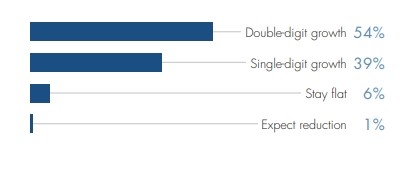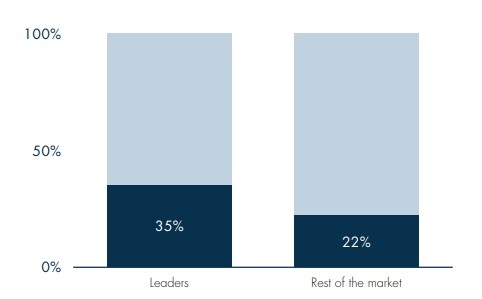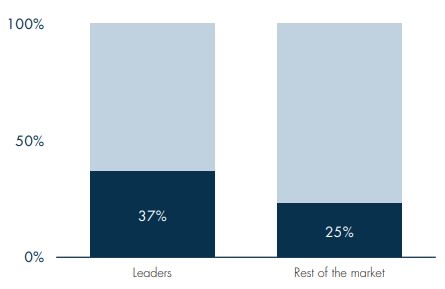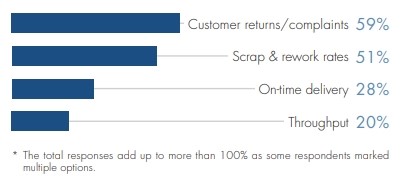Working in the manufacturing industry, you are no doubt familiar with the growing trend of Industrial IoT, also known as Industry 4.0, the Connected Factory or Digital Factory. We have all heard of and read about these and similar buzzwords a lot lately. The crucial need to drive productivity up and cost down, while maintaining high quality and reducing time to delivery, stems from fierce competition. This shift is no longer a question of “if” but “how”.
Today, factories are rushing to become digital, connected and smart more than ever before. But how do you optimally prepare for this digital transition and overcome its challenges? The best way for factories to learn is by looking at industry leaders and top-tier plant managers.
TRENDS IN DIGITAL MANUFACTURING 2018
A new survey has just been released, revealing top trends and challenges in digital manufacturing, examining how manufacturing industry executives are facing digitization and how they overcome related hurdles. This comprehensive survey was conducted via a collaboration between Plataine and SME.org.
The survey includes nearly 400 C-level manufacturing executives across a variety of verticals: from aerospace and automotive to furniture and chemicals. Their responses helped us understand:
-
- Their factories’ current level of digitization
- Their expectations for the digitization process
- and the concrete efforts & strategies they used to successfully digitize their factory.
Click here for a free copy of the survey.
Some key findings:
EXPECTED GROWTH DUE TO DIGITIZATION
Growth indications look optimistic: Almost all respondents (93%) are expecting single or double digit growth over the next three years; 54% expect double-digit growth. Only 7% expect their business growth curve to stay flat or to drop.
INCREASED-CAPACITY IS EXPECTED TO BE THE MAIN GROWTH ENGINE
We’ve also asked about potential growth areas, enabled by the Digital Factory. ‘Increased capacity’ was named the biggest growth area, with 62% expecting it to be the main enabler of their expected business growth.
Download your copy of the survey to learn more about manufacturing leaders’ thoughts on increased capacity.
WHEN IT COMES TO THE DIGITAL FACTORY, HOW DO INDUSTRY LEADERS BEHAVE?
In what areas do manufacturing industry leaders differ from the rest of the market? Two main questions were asked:
- Have you started implementing Industry 4.0?
- What level of digitization have you reached at the time of filling out the survey?
It seems that in relation to industry 4.0, industry leaders are engaged more than other industry players. 35% indicated that they have started implementing 4.0 initiatives as opposed to only 22% of other respondents.
Moreover, 37% of industry leaders have indicated that their organization is mostly or fully digital as opposed to 25% of other respondents. Having said that, only 2% of the respondents said they were already fully digital and automated. So there’s still room for improvement and optimization.
When asked which initiatives out of a breakdown of digital initiatives are part of their company’s Digital Factory strategy, respondents revealed four key digital factory initiatives. Supply Chain Collaboration was the most popular one. To learn more download your copy of the survey – free!
Concerns, challenges and benefits:
Our survey also reveals the concerns and challenges that industry players project, with regards to adopting IIoT technology and implementing industry 4.0
The survey indicates nine common digital transformation challenges that were raised in multiple industries, with the biggest one being ‘complexity of new systems integrations’ (44% of respondents), while the second runner up was reported to be ‘lack of human resources’ (29% of respondents).
And there are the challenges that manufacturing leaders are hoping digitization will help them resolve. ‘Increase manufacturing capacity’ leads the list (20% of respondents).
These benefits were also well recognized: ‘improve on-time delivery’ (19%), ‘reduce quality risks’ (18%), ‘shorten time-to-market’ (17%) and ‘streamline compliance requirements’ (8%).
KPI’s
You can’t really talk about growth without examining KPIs, and indeed, respondents were asked about the KPI’s they currently monitor, the most popular one (59%) being ‘customer returns/complaints’ (‘scrap and rework rates’ also appeared high on the list. As for the rework rate, respondents were asked about the state of their rework rate, and amazingly, nearly 40% do not know how to quantify it).
Here’s how top industry players quantify the impact of implementing industry 4.0 and IIOT on their KPIs:
To Summarize:
In this unique 2018 digital manufacturing survey we revealed important trends in manufacturing innovation, Industry 4.0 readiness and the journey that top tier manufacturing executives are making towards digital transformation. We gained insights into the best industry approaches to digitalization from those leading the pack, as well as the specifics of how industry leaders address the subject.
The survey reveals how industry leaders are digitally engaged and most of them have started implementing industry 4.0 initiatives. Moreover, because most of those we surveyed understand that implementing industry 4.0 technologies is a key in their future survival and success, they shared with us that their plants are already mostly or fully digital.
Digitization is viewed as a main enabler to increase business growth and efficiency. This means that in order to stay competitive, digitalization is mandatory.
Although the survey presents positive trends towards IIoT and digitalization, it shows that in the eyes of the players, manufacturing digitalization is challenging and by no means a riskless process.
Digitization is perceived as a process that consumes lots of resources, is complex and one that requires a lot of know-how and skilled professionals. But with the right technology and partners, success can be ensured and the benefits are endless.
Avner Ben-Bassat, President & CEO of Plataine












